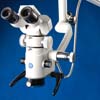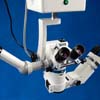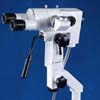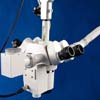Operations Upon The Lachrymal Apparatus
Operations Upon The Lachrymal ApparatusBy SAMUEL THEOBALD, M. D.,
OF BALTIMORE, MD.
Removal of the lachrymal Gland. This may be accomplished by either of two procedures: The gland may be exposed by an incision through the integument of the upper lid parallel with the orbital margin, drawn out by means of a tenaculum and, with a knife or scissors, separated from its attachments. The objection to this method is that it involves a more or less complete division of the levator palpebra superioris muscle, which may result in the production of ptosis. The other, and probably better, plan, suggested by Velpeau, is to divide the external canthus, evert the upper lid, and cut down upon the gland from the superior conjunctival cul de sac. This method does not endanger the integrity of the levator muscle, and leaves a less conspicuous sear than the first described procedure.
Bow a Is Operation for Fistula of the Lachrymal Gland.The purpose of this operation is to convert an external, cutaneous fistula into one opening into the conjunctival sac, and hence causing little or no annoyance.
A threaded needle is passed a short distance into the fistula, and is then made to transfix the lid, being brought out upon its conjunctival surface. A second needle, upon the other end of the thread, is next passed through the lid at a point close to the orifice of the fistula. The two ends are then tied tightly, and the thread is left to cut its way out. To promote the closure. of the external fistula its edges are freshened
Division of the Canaliculus. In performing this operation it is important that the edge of the knife should not be inclined forward; other wise a slight perceptible deformity will result, and, besides, the position of the divided canaliculus will not be the most favorable for carrying off the tears. Weber's beak pointed canaliculus knife (Fig. 415), or the modification of it shown in Fig. 416, is usually employed.
The operator should stand behind the patient, letting the patient's head (covered with a napkin) rest against his chest. the left hand being used for the left eye and the right hand for the right eye. The lid being kept upon the stretch with the thumb of the opposite hand, the probed tip of the canaliculus knife is introduced vertically into the punctum (which, together with the canaliculus, should have been dilated previously by the passage of one or two of the smallest sized probes), and then, the direction of the knife having been changed, it is passed horizontally along the canaliculus until its progress is arrested by the inner wall of the lachrymal sac (Fig. 417). This point having been reached, and the edge of the knife being directed upward or upward and slightly backward, the lid being kept still on the stretch, the canaliculus is divided by simply elevating the handle of the knife. If the operation is done as a preliminary step to the introduction of lachrymal probes, the canaliculus should be divided well up to its juncture with the sac; but if done for some other purpose, such as eversion of the punctum or stricture of the canaliculus, it may not be necessary to carry the division quite to this point.
The edges of the divided canaliculus usually show for several days a disposition to grow together, and to overcome this they must be separated every day or every other day by the passage of a greased probe. A few instillations of cocain render the operation of division of the canaliculus almost painless.
The foregoing description applies especially to division of the lower canaliculus; but the upper canaliculus, which, in the writer's experience, seldom needs to be divided, may be operated upon by essentially the same procedure.
Excision of the Lachrymal Sac. Owing to the delicate structure of the walls of the sac, this is not an operation easy of performance.
A vertical incision of sufficient length is made through the skin And the internal palpebral ligament down to the sac, which is then dissected out as carefully and completely as possible with a scalpel or a pair of blunt pointed scissors. After this the cavity left by the removal of the sac and the upper part of the nasal duct are scraped with a sharp spoon, and, the wound having been cleansed with an antiseptic solution, the edges of the incision are closed accurately with stitches and a suitable aseptic dressing applied.
Destruction of the Lachrymal Sac by Caustic Agents, etc.Destruction of the lachrymal sac by the actual cautery is an operation of classical origin, having been practised by the Romans nearly two thousand years since. In more recent times the obliteration of the sac has been effected by the use of caustic agents, such as nitrate of silver, chlorid of zinc, nitric acid, Vienna paste, caustic potash, etc., and still more recently by the thermocautery and the galvano cautery. The merit claimed for this procedure (and also for excision of the sac) is that it not only relieves the patient of the dacryocystitis and its unpleasant consequences, but that in some cases it cures the epiphora through the inhibitory influence which it appears to exert upon the activity of the lachrymal gland.
The usual method of performing this operation is to make a free incision into the sac through the external integument and the palpebral ligament, and through this to introduce the caustic or the tip of the galvano or thermo cautery, a Manfredi's speculum, being employed to protect the lips of the incision.
Introduction of Lachrymal Probes. Small probes are sometimes passed through the undivided canaliculus (to overcome occlusion of the puncta, etc.), but division of the canaliculus always precedes the passage of probes for the cure of occlusion of the nasal duct. Cocain lessens, but does not entirely do away with, the pain. It should always be used, however, and the probe should be anointed with vaselin containing 10 : 100 of cocain.
The writer prefers to stand behind the patient, using the left hand for the left eye and the right hand for the right eve, as in division of the canaliculus, since the patient's head can be more easily steadied in this position. The probe is passed horizontally along the canaliculus, the lid being kept upon the stretch with the thumb of the opposite hand, until its point comes in contact with the inner wall of the lachrymal sac; it is then turned into a vertical position and passed slowly through the duct until the floor of the nose is reached (Fig. 418). No especial difficulty attends the introduction of the large probes commended by the writer, provided they are properly constructed. It is of the first importance that their tips should not be too square and blunt. The accompanying illustration (Fig. 419), which represents the actual size of the largest probe of the series, Nos. 15 and 16, shows the proper shape of the ends as well as the curve which has been found most convenient.
Back to Resources
call toll-free:  or email
or email

 or email
or email
Categories
Categories
Dental
Dental Microscopes
Dental Microscopes
Ophthalmic
Ophthalmic Microscopes
Ophthalmic Microscopes
Gynecology
Gynecology Colposcopes
Gynecology Colposcopes




